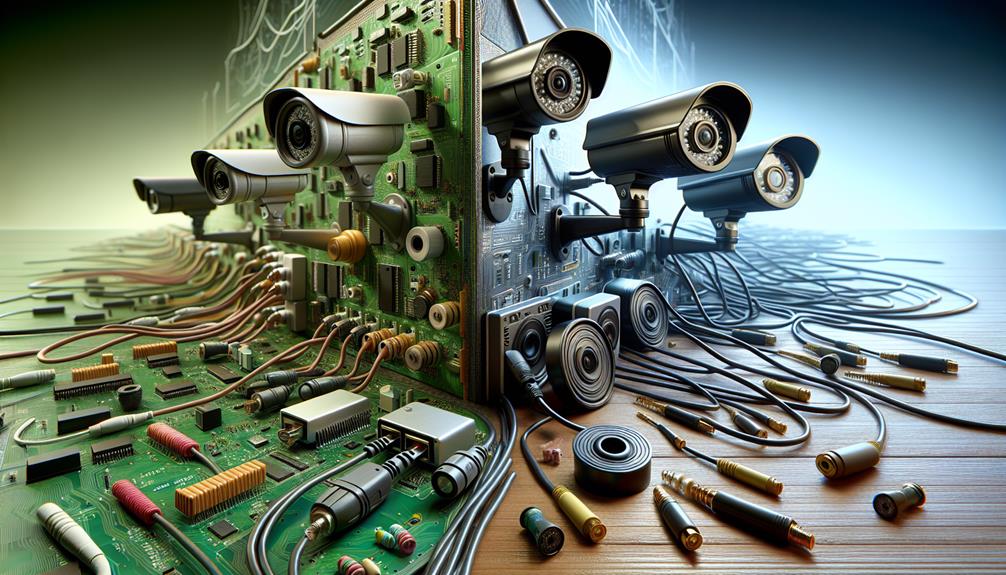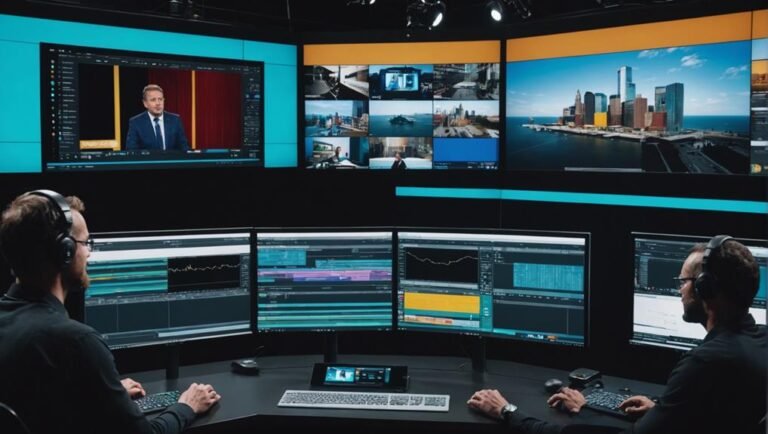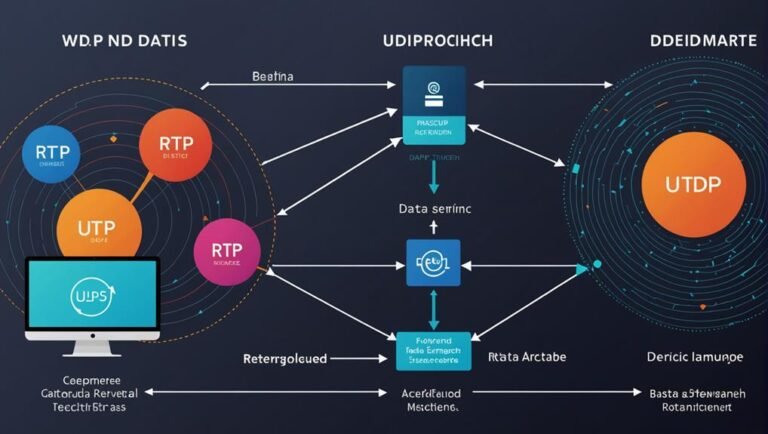When comparing CCTV with IP surveillance, IP systems clearly stand out. CCTV uses analog technology and requires coaxial cables, while IP surveillance leverages digital tech, connecting easily to your network. With IP cameras, you get higher resolution, better night vision, and real-time access from any location. They’re also simpler to install due to Power over Ethernet. Although CCTV might have lower upfront costs, IP systems offer long-term savings and superior scalability. Adding new cameras to an IP system is a breeze. Curious about more specifics? Find out which system better aligns with your needs and budget.
Technology Overview
To understand the differences between CCTV and IP surveillance, you first need to grasp the basic technology behind each system. CCTV, or Closed-Circuit Television, relies on analog technology. It uses coaxial cables to transmit video feeds from cameras to a central recording device, usually a DVR (Digital Video Recorder). This system operates within a closed loop, meaning the footage is not accessible over the internet without additional hardware.
On the other hand, IP surveillance systems leverage digital technology. IP, or Internet Protocol, cameras connect to your existing network infrastructure, like a Wi-Fi router or Ethernet switch. They transmit video data over the internet, making it accessible in real-time from any location with an internet connection. The data is typically stored on an NVR (Network Video Recorder) or even in the cloud, giving you more flexibility.
Choosing between these systems boils down to your need for mobility and accessibility. CCTV may seem restrictive since it confines you to a specific location for monitoring. In contrast, IP surveillance offers the liberty to check in from anywhere, providing you with greater freedom and control over your security.
Image Quality
When it comes to image quality, IP surveillance systems clearly outshine traditional CCTV setups. You’ll notice the difference right away. IP cameras boast higher resolution, delivering crystal-clear images that make it easier for you to identify faces, license plates, and other essential details. This superior image quality doesn’t just enhance your security; it also gives you peace of mind.
Here’s a quick comparison to help you see the benefits clearly:
| Feature | CCTV | IP Surveillance |
|---|---|---|
| Resolution | Low (up to 720p) | High (1080p and above) |
| Image Clarity | Grainy and blurry | Sharp and detailed |
| Night Vision | Limited | Advanced capabilities |
With IP surveillance, you get high-definition video, which means you won’t miss a thing. The sharpness and clarity are unparalleled, making your surveillance system truly effective. Plus, IP cameras often come with advanced night vision, ensuring that you get clear images even in low-light conditions.
The freedom to monitor your property with exceptional detail means you can respond swiftly and accurately to any situation. So, if image quality is a priority for you, IP surveillance is the way to go.
Installation Process
Not only do IP surveillance systems offer superior image quality, but they also simplify the installation process compared to traditional CCTV setups. With IP cameras, you don’t need to deal with a tangled mess of coaxial cables. These cameras use standard network cabling, often leveraging existing network infrastructure. This means less clutter and more flexibility when it comes to placement.
IP cameras also support Power over Ethernet (PoE), allowing you to power your cameras directly through the network cable. This eliminates the need for separate power sources, reducing installation time and complexity. Imagine the freedom of placing your cameras wherever you need them without worrying about proximity to power outlets.
Additionally, IP systems are expandable. Need to add more cameras? Just plug them into your network. You don’t need to overhaul the entire system, unlike with traditional CCTV setups. Plus, many IP cameras come with easy-to-use software that lets you configure and manage them right from your computer or mobile device.
In short, the installation process for IP surveillance systems is streamlined, giving you the freedom to set up a versatile surveillance network without the headaches associated with traditional CCTV systems.
Cost Comparison
Comparing the costs of CCTV and IP surveillance systems reveals significant differences that impact your budget and overall investment. CCTV systems have been around longer and generally come with lower upfront costs. You can buy analog cameras and DVR systems at a relatively affordable price, making them an attractive option if you’re looking to minimize initial expenses.
However, IP surveillance systems, while typically more expensive upfront, offer long-term savings. They use network infrastructure, which can reduce installation costs and maintenance fees over time. Plus, their higher resolution and advanced features often mean you need fewer cameras to cover the same area, further cutting down costs.
When considering the total cost of ownership, don’t forget to factor in the hidden expenses. CCTV systems might seem cheaper initially, but they often require more cabling and regular maintenance. IP systems, on the other hand, are built for easier upgrades and scalability, meaning you won’t need to overhaul your entire setup when expanding.
Ultimately, your choice will depend on your specific needs and budget. If you value long-term benefits and advanced features, investing in an IP surveillance system might be the best way to guarantee both security and financial freedom.
Scalability
Considering long-term benefits, scalability becomes an important factor when choosing between CCTV and IP surveillance systems. If you’re looking to expand your security network over time, IP surveillance systems are the clear winner. They offer easy integration with additional cameras and advanced features without significant overhauls. CCTV systems, on the other hand, often require extensive rewiring and upgrades to accommodate growth.
Here’s a quick comparison to help you understand:
| Feature | CCTV Systems | IP Surveillance Systems |
|---|---|---|
| Ease of Adding Cameras | Requires rewiring | Plug-and-play |
| Integration with Advanced Features | Limited | Highly flexible |
| Network Infrastructure | Analog-based | Digital-based |
| Expansion Cost | High | Moderate to low |
With IP surveillance, you can add new cameras to your existing network effortlessly. The digital nature of IP systems allows for seamless integration, making it easier to scale up or down based on your needs. Plus, IP systems often support higher resolution cameras, giving you better quality footage.
Security Features
When evaluating surveillance systems, you’ll find that IP surveillance offers a range of advanced security features that can greatly enhance your overall safety. Unlike traditional CCTV, IP cameras come equipped with encryption protocols, which guarantee that your data is secure from unauthorized access. This means you can enjoy peace of mind knowing your footage is safe from prying eyes.
Additionally, IP surveillance systems support remote access. You can monitor your property in real-time from anywhere, using a smartphone, tablet, or computer. This flexibility allows you to stay connected and in control, no matter where you are. It’s perfect for those who value both security and freedom.
IP cameras also feature advanced motion detection and analytics. They can differentiate between humans, animals, and other objects, reducing false alarms and ensuring you’re alerted only to genuine threats. Plus, these systems can integrate with other smart home devices, enhancing your overall security ecosystem.
The ability to store footage on the cloud rather than on physical devices means that even if someone tries to tamper with your cameras, your data remains intact and accessible. IP surveillance systems provide a robust, flexible, and secure solution for safeguarding your property.
Frequently Asked Questions
What Are the Maintenance Requirements for CCTV and IP Surveillance Systems?
You’ll need to regularly update software, check connections, and clean cameras. For IP systems, monitor network stability. For both, guarantee power supply reliability and occasional hardware inspections to keep everything running smoothly and hassle-free.
How Do Weather Conditions Affect CCTV and IP Cameras?
Did you know weather impacts 70% of outdoor cameras? Rain can blur lenses, snow obstructs views, and extreme temperatures damage hardware. Invest in weatherproof models to guarantee your surveillance stays reliable, rain or shine.
Can CCTV and IP Systems Be Integrated With Smart Home Devices?
You can absolutely integrate your surveillance systems with smart home devices. It’s all about using compatible technology. Once set up, you’ll have the freedom to monitor and control everything from your phone or tablet.
What Are the Environmental Impacts of CCTV Vs. IP Surveillance?
You’re concerned about environmental impacts? IP surveillance systems use less power and fewer resources compared to traditional CCTV. So, if you want to be eco-friendly, you should lean towards IP systems for your surveillance needs.
How Do Privacy Laws Impact the Use of CCTV and IP Surveillance?
Privacy laws limit your surveillance capabilities, ensuring you can’t invade others’ personal space. They require you to inform people about monitoring and protect their data, balancing security needs with individual freedoms. Always stay compliant!



